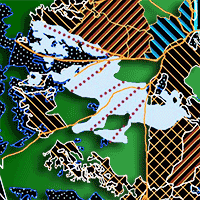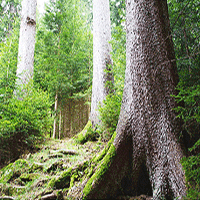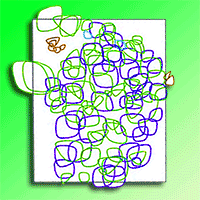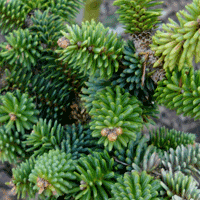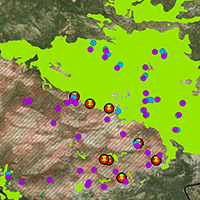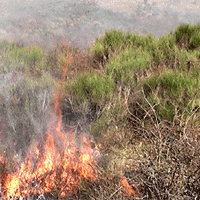In the Apennine mountains most pure silver fir stands originated from planting and were managed according to the traditional model, with clear cutting and a 100 year rotation. In the last decades in most of these stands there has been a change towards nature conservation and active management has stopped. The aim of this work was (1) to analyse stand dynamics and spontaneous regeneration processes that are taking place with increasing age in even aged fir plantations, and (2) to discuss if these processes can be useful for defining management approaches answering biodiversity conservation aims. The study was carried out in the Vallombrosa Forest (Central Italy). The relationship between fir stand age and structural parameters was analyzed using inventory data. Gap dynamics were monitored between 1983 and 2007 on the basis of remote sensing data. Based on a field survey of a sample of gaps, species composition and density of seedlings and saplings were analysed in relation to gap size and within-gap position. From 1983 to 2007 the number of gaps and their total area increased, following increasing stand age. Significant relationships (p < 0.01) were found between fir stand age and number of trees per hectare (r = -0.30), quadratic mean diameter (r = 0.65) and volume per hectare (r = 0.50). In the fir stands with lower stand density, a layer of trees with DBH < 15 cm had filled in the structure: fifteen different broadleaf species were recorded in this layer, usually mixed with fir. Gap size had an influence on presence of young firs (seedlings and fir < 0.5 m), which were significantly more numerous in gaps < 200 m2, but it had relatively limited influence on species diversity. Within-gap position did not influence regeneration density. Results indicate that a possible management option for gradually transforming even aged fir plantations in the Apennines into mixed, naturally regenerating systems, could be based on the creation of small gaps (< 200 m2) in the canopy cover, simulating the natural dynamics that are taking place in ageing fir plantations.
Keywords
, , , ,
Citation
Bottalico F, Travaglini D, Fiorentini S, Lisa C, Nocentini S (2014). Stand dynamics and natural regeneration in silver fir (Abies alba Mill.) plantations after traditional rotation age. iForest 7: 313-323. - doi: 10.3832/ifor0985-007
Academic Editor
Emanuele Lingua
Paper history
Received: Mar 04, 2013
Accepted: Dec 19, 2013
First online: Apr 08, 2014
Publication Date: Oct 01, 2014
Publication Time: 3.67 months
© SISEF - The Italian Society of Silviculture and Forest Ecology 2014
Open Access
This article is distributed under the terms of the Creative Commons Attribution-Non Commercial 4.0 International (https://creativecommons.org/licenses/by-nc/4.0/), which permits unrestricted use, distribution, and reproduction in any medium, provided you give appropriate credit to the original author(s) and the source, provide a link to the Creative Commons license, and indicate if changes were made.

Breakdown by View Type
(Waiting for server response...)
Article Usage
Total Article Views: 56753
(from publication date up to now)
Breakdown by View Type
HTML Page Views: 47047
Abstract Page Views: 3476
PDF Downloads: 4591
Citation/Reference Downloads: 24
XML Downloads: 1615
Web Metrics
Days since publication: 4267
Overall contacts: 56753
Avg. contacts per week: 93.10
Article Citations
Article citations are based on data periodically collected from the Clarivate Web of Science web site
(last update: Mar 2025)
Total number of cites (since 2014): 14
Average cites per year: 1.17
Publication Metrics
by Dimensions ©
Articles citing this article
List of the papers citing this article based on CrossRef Cited-by.
(1)
Albanesi E, Gugliotta OI, Mercurio I, Mercurio R (2008)Effects of gap size and within-gap position on seedlings establishment in silver fir stands. iForest 1: 55-59.
CrossRef |
Gscholar
(2)
Ammer C (1996)Impact of ungulates on structure and dynamics of natural regeneration of mixed mountain forests in the Bavarian Alps. Forest Ecology and Management 88: 43-53.
CrossRef |
Gscholar
(3)
Apollonio M, Ciuti S, Pedrotti L, Banti P (2010)Ungulates and their management in Italy. In: “European ungulates and their management in the 21th century” (Apollonio M, Andersen R, Putman R eds). Cambridge University Press, Cambridge, UK, pp. 475-505.
Gscholar
(4)
Attiwill PM (1994)The disturbance of forest ecosystems: the ecological basis for conservative management. Forest Ecology and Management 63: 247-309.
CrossRef |
Gscholar
(5)
Baier P, Meyer J, Gottlein A (2007)Regeneration niches of Norway spruce (
Picea abies L. Karst.) saplings in small canopy gaps in mixed mountain forests of the Bavarian Limestone Alps. European Journal of Forest Research 26: 11-22.
CrossRef |
Gscholar
(6)
Barbati A, Chirici G, Corona P, Montaghi A, Travaglini D (2009)Area-based assessment of forest standing volume by field measurements and airborne laser scanner data. International Journal of Remote Sensing 30: 5177-5194.
CrossRef |
Gscholar
(7)
Barbati A, Salvati R, Ferrari B, Di Santo D, Quatrini A, Portoghesi L, Travaglini D, Iovino F, Nocentini S (2012)Assessing and promoting old-growthness of forest stands: lessons from research in Italy. Plant Biosystems 146 (1): 167-174.
CrossRef |
Gscholar
(8)
Barzanti GP, Capretti P (1996)Morie nelle abetine del Monte Amiata associate ad Heterobasidion annosum [Silver fir stands mortality caused by
Heterobasidion annosum on Mount Amiata]. Monti e Boschi 6: 24-28. [in Italian]
Gscholar
(9)
Bianchi L, Paci M (2008)Dynamics and management of silver fir stand in Tuscany: a review of long-term research. Forest@ 5 (1): 122-130. [in Italian with English Abstract]
CrossRef |
Gscholar
(10)
Bobiec A (2007)The influence of gaps on tree regeneration: a case study of the mixed lime-hornbeam (Tilio-Carpinetum Tracz. 1962) communities in the Bialowieza a Primeval Forest. Polish Journal of Ecology 55 (3): 441-455.
Gscholar
(11)
Bolte A, Czajkowski T, Kompa T (2007)The north-eastern distribution range of European beech - a review. Forestry 80 (4): 413-429.
CrossRef |
Gscholar
(12)
Boncina A (2000)Comparison of structure and biodiversity in the Rajhenav virgin forest remnant and managed forest in the Dinaric region of Slovenia. Global Ecology and Biogeography 9: 201-211.
CrossRef |
Gscholar
(13)
Bottacci A, Grasso E, Padula M, Radicchi S (2012)Rilievi dendrometrici preparatori al Piano di gestione della Riserva Naturale Biogenetica di Camaldoli [Dendrometric survey for the Management Plan of the Natural Biogenetic Reserve of Camaldoli]. L’Italia Forestale e Montana 67 (4): 317-328. [in Italian]
CrossRef |
Gscholar
(14)
Bottalico F, Chirici G, Travaglini D (2012)La gestione della foresta di Vallombrosa dal 1876 al 2006. Analisi delle cartografie storiche [The forest management of Vallombrosa from 1876 to 2006: analysis of forest maps]. L’Italia Forestale e Montana 67 (6): 449-458. [in Italian]
CrossRef |
Gscholar
(15)
Bottero A, Garbarino M, Dukić V, Govedar Z, Lingua E, Nagel TA, Motta R (2011)Gap-phase dynamics in the old-growth forest of Lom, Bosnia and Herzegovina. Silva Fennica 45: 875-887.
CrossRef |
Gscholar
(16)
Brändli UB (1996)Die häufigsten waldbäume der schweiz. ergebnisse aus dem landesforstinventar 1983-1985: verbreitung, standort und häufigkeit von 30 baumarten. [The commonest forest trees in Switzerland. Findings from the National Forest Inventory 1983-1985: distribution, site and frequency of 30 tree species]. Ber. Eidgenöss. Forschanst. Wald Schnee Landsch. 342: 107-120. [in German]
Gscholar
(17)
Brokaw N, Busing RT (2000)Niche versus chance and tree diversity in forest gaps. Trends in Ecology and Evolution 15: 183-188.
CrossRef |
Gscholar
(18)
Busing RT, White PS (1997)Species diversity and small-scale disturbance in an old-growth temperate forest: a consideration of gap-partitioning concepts. Oikos 78: 562-568.
CrossRef |
Gscholar
(19)
Canham CD (1989)Different responses to gaps among shade-tolerant tree species. Ecology 70: 548-550.
CrossRef |
Gscholar
(20)
Capretti P (1998)Italy. In: “
Heterobasidion annosum: biology, ecology, impact and control” (Woodward S, Stenlid J, Karjalainen R, Hüttermann A eds). CAB International, Wallingford, Oxon, UK, pp. 377-385.
Gscholar
(21)
Carmignola G (2009)Il rilievo dell’influsso della fauna selvatica sul bosco nel Parco Nazionale dello Stelvio [Wild ungulates impact on forest regeneration in the Stelvio National Park (Italy)]. L’Italia Forestale e Montana 64: 95-108. [in Italian]
CrossRef |
Gscholar
(22)
Casanova P, Memoli A, Pini L (2009)Elementi per la gestione faunistica [Elements for wildlife management]. In: “La Riserva Naturale Statale Biogenetica di Vallombrosa. Piano di Gestione e Silvomuseo: 2006-2025” (Ciancio O ed). Tipografia Coppini, Firenze, Italy. [in Italian]
Gscholar
(23)
Caudullo G, De Battisti R, Colpi C, Vazzola C, Da Ronch F (2003)Ungulate damage and silviculture in the Cansiglio Forest (Veneto Prealps, NE Italy). Journal for Nature Conservation 10: 233-241.
CrossRef |
Gscholar
(24)
Ciancio O, Nocentini S (2006)The conservation of cultural forest landscapes: the Vallombrosa Silvomuseum. In: Proceedings of the “Cultural heritage and sustainable forest management: the role of traditional knowledge” (Parrotta J, Agnoletti M, Johann E eds). Ministerial Conference on the Protection of Forests in Europe, Liason Unit, Warsaw, Poland, vol. 1, pp. 237-242.
Gscholar
(25)
Ciancio O, Nocentini S (2011)Biodiversity conservation and systemic silviculture: concepts and applications. Plant Biosystems 145 (2): 411-418.
CrossRef |
Gscholar
(26)
Clauser F (1950)Tavola cormometrica per l’abetina di Vallombrosa [Volume table for the Fir wood of Vallombrosa]. L’Italia Forestale e Montana 5 (4): 195-196. [in Italian]
Gscholar
(27)
Collins BS, Dunne KP, Pickett STA (1985)Responses of forest herbs to canopy gaps. In: “The ecology of natural disturbance and patch dynamics” (Pickett TA and White PS eds). Academic Press, Orlando, FL,USA, pp. 218-234.
Gscholar
(28)
Degen T, Devillez F, Jacquemart AL (2005)Gaps promote plant diversity in beech forests (
Luzulo-Fagetum), North Vosges, France. Annals of Forest Science 62: 429-440.
CrossRef |
Gscholar
(29)
Denslow JS, Spies T (1990)Canopy gaps in forest ecosystems - an introduction. Canadian Journal of Forest Research 20: 619.
CrossRef |
Gscholar
(30)
Diaci J (2002)Regeneration dynamics in a Norway spruce plantation on a silver fir-beech forest site in the Slovenian Alps. Forest Ecology and Management 161: 27-38.
CrossRef |
Gscholar
(31)
Diaci J, Adamic T, Rozman A (2012)Gap recruitment and partitioning in an old-growth beech forest of the Dinaric Mountains: Influences of light regime, herb competition and browsing. Forest Ecology and Management 285: 20-28.
CrossRef |
Gscholar
(32)
Dobrowolska D, Veblen T (2008)Treefall-gap structure and regeneration in mixed Abies alba stands in central Poland. Forest Ecology and Management 255: 3469-3476.
CrossRef |
Gscholar
(33)
Dubé P, Menard A, Bouchard A, Marceau DJ (2005)Simulating the impact of small-scale extrinsic disturbances over forest volumetric light environment. Ecological modelling 182 (2): 113-129.
CrossRef |
Gscholar
(34)
Eiberle K, Zehnder U (1985)Kriterien zur Beurteilung des Wildverbisses bei der Weisstanne [Criteria for assessing browsing damage in Silver fir]. Schweizerische Zeitschrift für Forstwesen 136: 399-414. [in German]
Gscholar
(35)
Elling W, Dittmar C, Pfaffelmoser K, Rötzer T (2009)Dendroecological assessment of the complex causes of decline and recovery of the growth of fir (
Abies alba Mill.) in southern Germany. Forest Ecology and Management 257: 1175-1187.
CrossRef |
Gscholar
(36)
Fantoni I (2000)Diffusione del Rampichino alpestre (
Certhia familiaris) e relazione con le caratteristiche stazionali e forestali delle abetine nel Parco Nazionale delle Foreste Casentinesi, Monte Falterona e Campigna [Treecreeper (
Certhia familiaris) distribution and relationships with Silver fir stands and site features in the Casentino, Monte Falterona and Campigna Forests National Park]. Bsc thesis, University of Florence, Firenze, Italy, pp. 97. [in Italian]
Gscholar
(37)
Farina P, Capretti P, Mugnai L (1990)Gruppi intersterili di
Heterobasidion annosum: osservazioni nella foresta di Vallombrosa [Intersterile groups of
Heterobasidium annosum: observations in the Vallombrosa Forest]. L’Italia Forestale e Montana 45 (5): 347-360. [in Italian]
Gscholar
(38)
Ficko A, Poljanec A, Boncina A (2011)Do changes in spatial distribution, structure and abundance of silver fir (
Abies alba Mill.) indicate its decline? Forest Ecology and Management 261: 844-854.
CrossRef |
Gscholar
(39)
Gabbrielli A (2000)Le storiche abetine di Vallombrosa [The historical fir stands of Vallombrosa]. L’Italia Forestale e Montana 55 (6): 381-385. [in Italian]
Gscholar
(40)
Gabbrielli A (2003)Viaggio in Italia sulle tracce dell’abete bianco [Journey in Italy on the trail of Silver fir]. Annali dell’Accademia Italiana di Scienze Forestali 52: 125-207. [in Italian]
Gscholar
(41)
Gálhidy L, Mihók B, Hagyó A, Rajkai K, Standovár T (2006)Effects of gap size and associated changes in light and soil moisture on the understorey vegetation of a Hungarian beech forest. Plant Ecology 183: 133-145.
CrossRef |
Gscholar
(42)
Garbarino M, Mondino EB, Lingua E, Nagel TA, Dukic T, Govedar Z, Motta R (2012)Gap disturbances and regeneration patterns in a Bosnian old-growth forest: a multispectral remote sensing and ground-based approach. Annals of Forest Science 69: 617-625.
CrossRef |
Gscholar
(43)
Gill RMA (1992a)A review of damage by mammals in north temperate forests. 1. Deer. Forestry 65 (2): 145-169.
CrossRef |
Gscholar
(44)
Gill RMA (1992b)A review of damage by mammals in north temperate forests. 3. Impact on trees and forests. Forestry 65: 363-388.
CrossRef |
Gscholar
(45)
Johann E (2006)Historical development of nature-based forestry in central Europe. In: “Nature-based forestry in Central Europe: alternatives to industrial forestry and strict preservation” (Diaci J ed). Studia Forestalia Slovenica 126, Ljubljana, pp. 1-17.
Gscholar
(46)
Johann E (2007)Traditional forest management under the influence of science and industry: the story of the alpine cultural landscapes. Forest Ecology and Management 249: 54-62.
CrossRef |
Gscholar
(47)
Kandler O, Innes JL (1995)Air pollution and forest decline in central Europe. Environmental Pollution 90 (2): 171-180.
CrossRef |
Gscholar
(48)
Kenderes K, Mihók B, Standovár T (2008)Thirty years of gap dynamics in a central European beech forest reserve. Forestry 81 (1): 111-123.
CrossRef |
Gscholar
(49)
Kint V (2005)Structural development in ageing temperate Scots pine stands. Forest Ecology and Management 214 (1-3): 237-250.
Gscholar
(50)
Klimo E, Hager H, Kulhavy J (2000)Spruce monocultures in central Europe. Problems and prospects. EFI Proceedings 33, European Forest Institute, Joensuu, Finland, pp. 208.
Gscholar
(51)
Kramer W (1992)Die Weisstanne (
Abies alba Mill.) in Ost- und Südosteuropa: Eine Zustandbeschreibung [Description of the situation of Silver fir (
Abies alba Mill.) in eastern and southern Europe]. Gustav Fischer Verlag, Stuttgart, Jena, New York, pp. 405. [in German]
Gscholar
(52)
Kucbel S, Jaloviar P, Saniga M, Vencurik J, Klimas V (2010)Canopy gaps in an old-growth fir-beech forest remnant of Western Carpathians. European Journal of Forest Research 129: 249-259.
CrossRef |
Gscholar
(53)
Kuuluvainen T, Penttinen A, Leinonen K, Nygren M (1996)Statistical opportunities for comparing stand structural heterogeneity in managed and primeval forests: an example from boreal spruce forest in southern Finland. Silva Fennica 30: 315-328.
CrossRef |
Gscholar
(54)
Larsen JB (1986)Das Tannensterb: eine neue Hypothese zur Klärung des Hintergrundes dieser rätselhaften Komplexkrankheit der Weißtanne (
Abies alba Mill.) [Fir dieback: a new hypothesis for clarifying the background of this mysterious complex sickness of silver fir (Abies alba Mill.)]. Forstwissenschaftliches Centralblatt 105: 381-396. [in German]
CrossRef |
Gscholar
(55)
Leibundgut H (1976)Die grössten Fichten und Tanen [The largest spruce and fir]. Schweizerische Zeitschrift für Forstwesen 127 (6): 427. [in German]
Gscholar
(56)
Lertzman KP (1992)Patterns of gap-phase replacement in a subalpine, old-growth forest. Ecology 73: 657-669.
CrossRef |
Gscholar
(57)
Lombardi F, Klopcic M, Di Martino P, Tognetti R, Chirici G, Boncina. A, Marchetti M (2012)Comparison of forest stand structure and management of silver fir-European beech forest type in Central Apennines, Italy and in Dinaric Mountains, Slovenia. Plant Biosystems 144 (1): 114-123.
CrossRef |
Gscholar
(58)
Magini E (1967)Ricerche sui fattori della rinnovazione naturale dell’abete bianco sull’Appennino [Research on natural regeneration factors of silver fir in the Apennins]. L’Italia Forestale e Montana 22 (6): 261-270. [in Italian]
Gscholar
(59)
Mansourian S, Vallauri D, Dudley N (2005)Forest restoration in landscapes: beyond planting trees. Springer, New York, USA, pp. 437.
Gscholar
(60)
Martini I (2011)Composizione e struttura della comunità ornitica nidificante nella Riserva Naturale Statale Biogenetica di Vallombrosa [Composition and structure of bird nesting species in Vallombrosa Biogenetic Natural Reserve]. Bsc Thesis, Faculty of Agronomy, University of Florence, Florence, Italy, pp. 110. [in Italian]
Gscholar
(61)
Mattheus U, Ammer U (2000)Conversion of Norway spruce (
Picea abies L.) stands into mixed stands with Norway spruce and Beech (
Fagus sylvatica L.). Effects on the stand structure in two different test areas. In: “Spruce monocultures in Central Europe - Problems and prospects” (Klimo E, Hager H, Kulhavy J eds). EFI Proceedings 33, European Forest Institute, Joensuu, Finland, pp. 71-80.
Gscholar
(62)
McCarthy J (2001)Gap dynamics of forest trees: a review with particular attention to boreal forests. Environmental Reviews 9: 1-59.
CrossRef |
Gscholar
(63)
Motta R (1996)Impact of wild ungulates on forest regeneration and tree composition of mountain forests in the western Italian Alps. Forest Ecology and Management 88 (1-2): 93-98.
CrossRef |
Gscholar
(64)
Motta R, Garbarino F (2003)Stand history and its consequences for the present and future dynamic in two silver fir (
Abies alba Mill.) stands in the high Pesio Valley (Piedmont, Italy). Annals of Forest Science 60: 361-370.
CrossRef |
Gscholar
(65)
Mountford EP, Savill PS, Bebber DP (2006)Patterns of regeneration and ground vegetation associated with canopy gaps in a managed beechwood in southern England. Forestry 79: 389-408.
CrossRef |
Gscholar
(66)
Nagel TA, Svoboda M (2008)Gap disturbance regime in an old-growth
Fagus-Abies forest in the Dinaric Mountains, Bosnia-Herzegovina. Canadian Journal of Forest Research 38: 2728-2737.
CrossRef |
Gscholar
(67)
Niemela T, Korhonen K (1998)Taxonomy of the genus
Heterobasidion. In: “
Heterobasidion annosum: biology, ecology, impact and control” (Woodward S, Stenlid J, Karvalaines R, Hüttermann A eds). CAB International, Wallingford, Oxon, UK, pp. 27-33.
Gscholar
(68)
Nilsson SG, Niklasson M, Hedin J, Aronsson G, Gutowski JM, Linder P, Ljungberg H, Mikusinski G, Ranius T (2002)Densities of large living and dead trees in old-growth temperate and boreal forests. Forest Ecology and Management 161: 189-204.
CrossRef |
Gscholar
(69)
Nocentini S (2009)Structure and management of beech (
Fagus sylvatica L.) forests in Italy. iForest 2: 105-113.
CrossRef |
Gscholar
(70)
Paci M, Ciampelli F (1996)Risposta della vegetazione all’apertura di gap nella Riserva Naturale Integrale di Sasso Fratino [Vegetation response to gap creations in the Sasso Fratino Natural Reserve]. Monti e Boschi 2: 50-58. [in Italian]
Gscholar
(71)
Paluch JG (2007)The spatial pattern of a natural European beech (
Fagus sylvatica L.)-silver (
Abies alba Mill.) forest: a patch-mosaic perspective. Forest Ecology and Management 253: 161-170.
CrossRef |
Gscholar
(72)
PCI (2001)OrthoEngine Reference Manual, Version 8.2 (Oct 2001). PCI Geomatics, Richmond Hill, Ontario, Canada, pp. 184.
Gscholar
(73)
Pedersen BS, Howard JL (2004)The influence of canopy gaps on overstory tree and forest growth rates in a mature mixed-age, mixed-species forest. Forest Ecology and Management 196: 351-366.
CrossRef |
Gscholar
(74)
Peterken GF (1996)Natural woodland. Ecology and conservation in northern temperate regions. Cambridge University Press, Cambridge, UK, pp. 552.
Gscholar
(75)
Petritan AM, Nuske RS, Petritan IC, Tudose NC (2013)Gap disturbance patterns in an old-growth Sessile oak (
Quercus petraea L.) - European beech (
Fagus sylvatica L.) forest remnant in the Carpathian Mountains, Romania. Forest Ecology and Management 308: 67-75.
CrossRef |
Gscholar
(76)
Pham AT, de Grandpre L, Gauthier S, Bergeron Y (2004)Gap dynamics and replacement patterns in gaps of the northeastern boreal forest of Quebec. Canadian Journal of Forest Research 34: 353-364.
CrossRef |
Gscholar
(77)
Poulson TL, Platt WJ (1989)Gap light regimes influence canopy tree diversity. Ecology 70: 553-555.
CrossRef |
Gscholar
(78)
Puettmann KJ, Coates KD, Messier C (2009)A critique of silviculture. Managing for complexity. Island Press, Washington, DC, USA, pp. 206.
Gscholar
(79)
Rugani T, Diaci J, Hladnik D (2013)Gap dynamics and structure of two old-growth beech forest remnants in Slovenia. PLoS ONE 8 (1): e52641.
CrossRef |
Gscholar
(80)
Runkle JR (1982)Patterns of disturbance in some old-growth mesic forests of eastern North-America. Ecology 63: 1533-1546.
CrossRef |
Gscholar
(81)
Runkle JR (1989)Synchrony of regeneration, gaps, and latitudinal differences in tree species- diversity. Ecology 70: 546-547.
CrossRef |
Gscholar
(82)
Runkle JR (1992)Guidelines and sample protocol for sampling forest gaps. General Technical Report PNW-GTR-283, USDA Forest Service, Portland, OR, USA, pp. 44.
Gscholar
(83)
Seidl R, Fernandes PM, Fonseca TF, Gillet F, Jönsson AM, Merganičová K, Netherer S, Arpaci A, Bontemps JD, Bugmann H, González-Olabarria JR, Lasch P, Meredieu C, Moreira F, Schelhaas MJ, Mohren F (2011)Modelling natural disturbances in forest ecosystems: a review. Ecological Modelling 222: 903-924.
CrossRef |
Gscholar
(84)
Senn J, Suter W (2003)Ungulate browsing on fir (
Abies alba Mill.) in the Swiss Alps: beliefs in search of supporting data. Forest Ecology and Management 181: 151-164.
CrossRef |
Gscholar
(85)
Senni L (1955)L’abete bianco sull’Appennino italiano [Silver fir on Italian Apennines]. In: Proceedings of the “Congresso Nazionale Selvicoltura per il Miglioramento e la Conservazione dei Boschi Italiani”. Accademia Italiana di Scienze Forestali, Firenze, Italy, vol. 1, pp. 225-236.
Gscholar
(86)
Sitzia T, Trentanovi G, Dainese M, Gobbo G, Lingua E, Sommacal M (2012)Stand structure and plant species diversity in managed and abandoned silver fir mature woodlands. Forest Ecology and Management 270: 232-238.
CrossRef |
Gscholar
(87)
Stokland JN, Siitonen J, Jonsson BG (2012)Biodiversity in dead wood. Cambridge University Press, Cambridge, UK, pp. 509.
Gscholar
(88)
Suorsa P, Huhta E, Jäntti A, Nikula A, Helle H, Kuitunen M, Koivunen V, Hakkarainen H (2005)Thresholds in selection of breeding habitat by the Eurasian treecreeper (
Certhia familiaris). Biological Conservation 121 (3): 443-452.
CrossRef |
Gscholar
(89)
Tellini Florenzano G (2004)Birds as indicators of recent environmental changes in the Apennines (Foreste Casentinesi National Park, central Italy). Italian Journal of Zoology 71 (4): 317-324.
CrossRef |
Gscholar
(90)
Travaglini D, Paffetti D, Bianchi L, Bottacci A, Bottalico F, Giovannini G, Maltoni A, Nocentini S, Vettori C, Calamini G (2012)Characterization, structure and genetic dating of an old-growth beech-fir forest in the northern Apennines (Italy). Plant Biosystems 146 (1): 175-188.
CrossRef |
Gscholar
(91)
Uotila A, Maltamo M, Uuttera J, Isomäki A (2001)Stand structure in seminatural and managed forests in eastern Finland and Russian Karelia. Ecological Bulletins 49: 149-158.
Online |
Gscholar
(92)
Vazzano E, Quilghini G, Travaglini D, Nocentini S (2011)Changes in forest cover in the
Foresta della Lama (Casentino Forests National Park) from Karl Siemon’s and Anton Seeland’s 1837 forest management plan. Forest@ 8 (1): 78-87. [in Italian with English abstract]
CrossRef |
Gscholar
(93)
Veblen TT (1992)Regeneration dynamics. In: “Plant succession: theory and prediction” (Glenn-Lewin DC, Peet RK eds). Chapman and Hall, London, UK, pp. 152-187.
Gscholar
(94)
Volarik D, Hedl R (2013)Expansion to abandoned agricultural land forms an integral part of silver fir dynamics. Forest Ecology and Management 292: 39-48.
CrossRef |
Gscholar
(95)
Vrška T, Adam D, Hort L, Kolár T, Janík D (2009)European beech (
Fagus sylvatica L.) and silver fir (
Abies alba Mill.) rotation in the Carpathians - a developmental cycle or a linear trend induced by man? Forest Ecology and Management 258: 347-356.
CrossRef |
Gscholar
(96)
Wagner S, Collet C, Madsen P, Nakashizuka T, Nyland RD, Sagheb-Talebi K (2010)Beech regeneration research: from ecological to silvicultural aspects. Forest Ecology and Management 259: 2172-2182.
CrossRef |
Gscholar
(97)
Watt AS (1947)Pattern and process in the plant community. The Journal of Ecology 35: 1-22.
CrossRef |
Gscholar
(98)
Whitmore TC (1989)Canopy gaps and the two major groups of forest trees. Ecology 70: 536-538.
CrossRef |
Gscholar
(99)
Woods KD (1984)Patterns of tree replacement: canopy effects on understory pattern in hemlock-northern hardwood forests. Plant Ecology 56: 87-107.
Gscholar
(100)
Woods KD (2000)Dynamics in late-successional hemlock-hardwood forests over three decades. Ecology 81: 110-126.
CrossRef |
Gscholar
(101)
Zerbe S (2002)Restoration of natural broad-leaved woodland in central Europe on sites with coniferous forest plantations. Forest Ecology and Management 167 (1-3): 27-42.
CrossRef |
Gscholar
(102)
Zhang K (2008)Identification of gaps in mangrove forests with airborne LIDAR. Remote Sensing of Environment 112: 2309-2325.
CrossRef |
Gscholar



